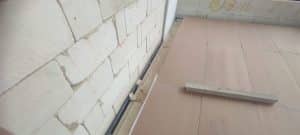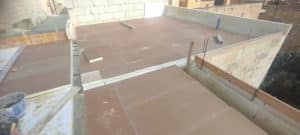When you’re planning to renovate a home or commercial space in Malta, microcement often comes up as a sleek, stylish, and practical surface option. But with so many flooring and wall finish choices out there, one question often makes homeowners hesitate: Does microcement crack easily?
The short answer? No, microcement does not crack easily—if it’s properly installed and maintained. That said, let’s dive deeper into the science, the real-life applications, and why this decorative finish is gaining so much popularity in Malta and beyond.
1. What Is Microcement and Why Do People Love It?| Does Microcement Crack Easily
Microcement is a high-performance, polymer-modified cement-based coating that’s applied in ultra-thin layers (usually 2–3mm thick). It adheres directly to surfaces like tiles, concrete, plaster, and more without the need for demolition.
But why is everyone in Malta—from boutique hotel owners to homeowners—talking about it?
Seamless look: There are no joints, which means easier cleaning and a sleek finish.
Durability: Despite being thin, microcement is exceptionally tough.
Versatility: Use it on walls, floors, ceilings, furniture, stairs, bathrooms, and even swimming pools.
Now that we know what it is, let’s address the big concern…
2. Does Microcement Crack Easily? Here’s the Truth| Does Microcement Crack Easily
If applied correctly, microcement does not crack easily. Unlike traditional concrete or tile grout that can develop stress fractures, microcement is formulated to be flexible and resist cracking under everyday use.
Why Microcement Doesn’t Crack Easily:
Elastic properties: The polymers in microcement allow it to move slightly with the surface beneath it. This flexibility is key in preventing cracks.
Layered application: Microcement is applied in multiple thin coats, each strengthening the next. This adds to its structural integrity.
Protective sealers: A high-quality sealer—like the one used by our experts at Kibitec—acts as a waterproof and protective top layer that also absorbs some micro-movements.
Of course, no material is invincible. Let’s look at what might cause microcement to crack—and how you can prevent it.
3. When Does Microcement Crack? The Real Reasons| Does Microcement Crack Easily
Although rare, cracks in microcement can occur under specific conditions. It’s usually not a fault of the material itself, but rather issues with what lies underneath or how it was applied.
Common Causes of Cracking:
Poor surface preparation: If the substrate (the surface underneath) is not clean, stable, or level, it can shift over time.
Structural movement: If the foundation or base material moves significantly—due to settling or water damage—the microcement may crack as a result.
Incorrect installation: DIY jobs or poorly trained workers may skip vital steps like mesh reinforcement or proper layering.
💡 Pro Tip for Malta homeowners: Always go with a certified installer. At Kibitec, we ensure every microcement application includes mesh reinforcement and flexible sealers, drastically reducing the risk of cracking.
4. How to Prevent Cracks: Installation & Maintenance Tips| Does Microcement Crack Easily
To ensure a flawless finish that lasts for years, installation and upkeep are key. Here’s what you need to know:
✅ Step-by-Step Best Practices:
Inspect the substrate: It must be clean, stable, and free of major cracks.
Use a mesh layer: This provides reinforcement and absorbs movement.
Apply primer: It improves adhesion and stabilises the surface.
Apply microcement in layers: 2 to 3 thin coats are better than one thick one.
Finish with a durable sealer: This protects against moisture and micro-movements.
💧 Bonus Tip: Waterproofing
Even though the microcement itself isn’t waterproof, we apply a high-quality sealer that makes it water-resistant and durable, perfect for use in bathrooms, kitchens, or outdoor terraces in Malta’s Mediterranean climate.
Routine maintenance is simple—just avoid harsh cleaners and heavy impacts. With proper care, you’ll enjoy a crack-free surface for years.
5. Real-Life Use Cases in Malta: Microcement That Doesn’t Crack| Does Microcement Crack Easily
We’ve worked with hundreds of clients in Malta—from Sliema penthouses to Gozo farmhouses—who have chosen microcement for its beauty, versatility, and performance.
Here are a few examples:
🏠 Home Floors in St. Julian’s:
A homeowner installed microcement over their existing tile floor. With proper surface prep and mesh reinforcement, the floor looks flawless a year later—no cracks, no issues.
🛁 Bathroom Walls in Valletta:
The client was concerned about humidity causing microcement to crack. With our moisture-resistant sealer and breathable primer, the walls have stayed pristine.
🏨 Hotel Reception in Mdina:
Heavy foot traffic? No problem. We used an industrial-grade topcoat to ensure no micro cracks formed even under constant use.
These examples prove that with professional application, microcement remains smooth, beautiful, and crack-free, even in high-demand environments.
A Quick Note on Construction Materials| Does Microcement Crack Easily
Microcement is just one innovation in the broader world of construction. As building techniques evolve, so do surface treatments, finishes, and materials—allowing for smarter, more resilient designs in both residential and commercial spaces.
6. Microcement vs Tiles & Concrete: Which Cracks More?| Does Microcement Crack Easily
If you’re comparing finishes and wondering Does microcement crack easily compared to tile or concrete?, you’re not alone. Let’s break it down.
🧱 Traditional Concrete
Prone to Shrinkage Cracks: Concrete expands and contracts due to temperature and moisture, which often leads to cracking unless control joints are added.
Rigid and Brittle: Once set, concrete has no give, which makes it more vulnerable to cracking under structural stress.
Requires More Thickness: Standard concrete installations need far more depth than microcement, making it heavier and slower to apply.
✅ Microcement Advantage: Thinner, more flexible, and quicker to apply. It also adapts better to slight movements in Malta’s older buildings, which is especially important when renovating traditional properties in cities like Mdina or Vittoriosa.
🔳 Ceramic or Porcelain Tiles
Crack Along Grout Lines: While tiles themselves are strong, the grout between them is often the first place cracks show up—especially in humid or shifting environments.
Crack from Substrate Issues: Tiles can crack if the base isn’t level or shifts over time. They’re not forgiving materials.
✅ Microcement Advantage: No grout lines = fewer weak points. Plus, it forms a continuous surface that flexes slightly, offering better protection against cracking.
So, if you’re concerned about long-term durability with minimal risk of cracking, microcement is the superior choice, especially when installed professionally.
7. Common Myths About Microcement and Cracking| Does Microcement Crack Easily
Like many modern construction materials, microcement suffers from a few persistent myths. Let’s set the record straight:
❌ Myth 1: “Microcement is fragile because it’s thin.”
Truth: Thickness isn’t always an indicator of strength. Microcement is fortified with resins and polymers that give it high mechanical resistance. When applied in layers and sealed correctly, it can handle heavy traffic, water, and wear with ease.
❌ Myth 2: “All microcement cracks eventually.”
Truth: This only happens with bad application or faulty substrates. With mesh reinforcement, breathable primers, and elastic topcoats, microcement becomes a crack-resistant powerhouse.
❌ Myth 3: “Cracks mean microcement is low quality.”
Truth: The material itself is not usually the issue—the quality of the installation is everything. That’s why working with a trusted company like Kibitec is essential.
8. Caring for Microcement in Malta’s Climate| Does Microcement Crack Easily
Malta’s Mediterranean weather—sunny summers, humid winters, and sea breezes—can affect building materials. But microcement holds up beautifully when installed and maintained properly.
Here’s how to make sure your microcement stays pristine:
🧽 Regular Cleaning:
Use pH-neutral soap and warm water.
Avoid acidic cleaners and rough scrubbing tools that can degrade the sealer.
🔧 Avoid Heavy Impacts:
While it’s durable, dropping a heavy object with force could damage the surface. Use felt pads under furniture and avoid dragging items across the floor.
🔄 Re-Sealing (Every 3–4 Years):
Like any sealed surface, microcement benefits from a fresh topcoat periodically. This restores waterproofing, shine, and resistance to micro-abrasions.
In short: it’s low-maintenance, but not no-maintenance. With proper care, your surfaces will look incredible for over a decade—even in high-moisture areas like bathrooms or outdoor patios.
9. How Much Does Microcement Cost in Malta?
You might be surprised to learn that this premium-looking finish is actually affordable.
💶 Prices typically start at around €65 per square metre, depending on the complexity of the surface and the type of finish you choose (e.g., matte, satin, or gloss).
This includes:
Professional preparation of the surface
Multiple layers of microcement
Reinforcement mesh where needed
Primer and final protective sealers
For large-scale projects or specialty areas like stairs or pools, the cost may increase. But compared to removing tiles or pouring fresh concrete, microcement saves time, labour, and cost in the long run.
Want an accurate quote tailored to your space? Contact us today for a free consultation at Kibitec.
10. Final Verdict: Does Microcement Crack Easily?
Let’s bring it all together.
👉 No, microcement does not crack easily—especially when installed correctly on a properly prepared surface. It’s flexible, layered, reinforced, and sealed to withstand stress and moisture.
In fact, compared to tiles or traditional concrete, microcement is one of the most crack-resistant finishes you can choose—which is why it’s becoming so popular in Malta’s homes, hotels, and businesses.
Contact Us to Get Crack-Free Microcement Surfaces in Malta
Ready to transform your space with a durable, seamless, and modern finish? Whether it’s a small bathroom makeover or a full-floor renovation, Kibitec is your trusted partner in Malta for premium microcement solutions.
📞 Talk to our team today! We’ll answer all your questions, provide a no-obligation quote, and guide you on everything from design to installation.
👉 Contact us now and bring your microcement vision to life—without the cracks.




